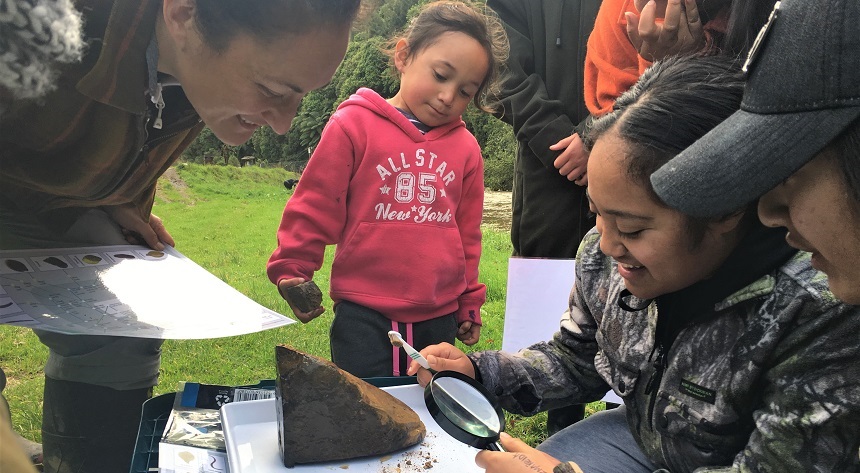Vision Mātauranga
Māori have strong connections to Aotearoa New Zealand's environment, with valuable inter-generational views and belief systems that can underpin decision-making, governance and stewardship.

We have embraced Te Ao Māori throughout the Challenge, because these values strengthen our commitment to leaving a legacy in the Aotearoa science and innovation system. Many of the research projects we’re involved with have Mātauranga Māori embedded in them.
Our work to date has placed us in a strong position to step up to a new level of commitment and respectful partnership at all levels of the Challenge, and to demonstrate leadership in the wider Aotearoa innovation system. One example of our work is helping to get Te Tira Whakamātaki – the Māori Biosecurity Network – off the ground.
To ensure Māori researchers and/or iwi, hapū and whānau are embedded in the Challenge, all future investments must demonstrate at least a three on the Vision Mātauranga Classification scale – see below for details on this.
Our Māori Strategy
- We take a proactive role in partnerships with Māori researchers and communities.
- We create opportunities for emerging Māori leaders and explore co-leadership models.
- We seek to build capacity amongst non-Māori researchers and end-users to enable them to work confidently in partnership with tangata whenua.
- We invest in kaupapa Māori and Māori-led research.
- Co-design is a cornerstone of the way we work.
- We partner with other entities seeking to build Māori capability and capacity across the New Zealand innovation system.
- We enrich our research and innovation investments by blending Mātauranga Māori with contemporary research methods.
Vision Mātauranga
Vision Mātauranga (VM) is a New Zealand Government science policy framework, with the goal of unlocking the science and innovation potential of Māori knowledge, resources and people for the benefit of all New Zealanders. Vision Mātauranga is woven through the structure and function of this Challenge.
We have a Co-Director Māori and other Māori representatives on our Executive Leadership and Wider Leadership Groups. They provide advice and support on VM principles and concepts, Māori world views, tikanga, mātauranga, language, research priorities, and methodologies.
In addition, we have a number of Māori knowledge brokers and Mana Rangatira members, all of whom work to ensure the Challenge operates in accordance with the VM principles set out in the Challenge’s Collaboration Agreement. They also ensure coherence across the Challenge, provide a pathway to building VM expertise among the Programme Leaders and other senior staff, and lead Māori-centred research.
Vision Mātauranga classifications
- Research with no specific Māori component: science-based project with no mātauranga Māori (Māori knowledge) used. Māori are not associated with the research process (e.g. not on any research management/advisory/governance panels, it is not inclusive of Māori land or institutions, nor the subject of any component of the research). Work may be of general interest to Māori, though no more so than to any other end users or stakeholders.
- Research specifically relevant to Māori: science-based project of specific relevance to Māori as end users and stakeholders. Māori are not typically involved in the research. Mātauranga Māori and values may be used in a minor way to guide the work and its relevance to Māori. Can include work that contributes to Māori aspirations and outcomes.
- Research involving Māori: science-based project where mātauranga Māori (about 20–50%) may be collected and incorporated in the project, but not central to the project. Research is specifically and directly relevant to Māori as end users and stakeholders. Māori are involved in the design and/or undertaking of the research (e.g. as research participants; on management/advisory/governance panels; as co-producers, partners, co-funders). The work typically contributes to Māori (e.g. iwi/hapū, organisations) aspirations and outcomes.
- Māori-centred research: Māori-led project, where a large amount of mātauranga Māori is used and understood (about 50%+) and combined with science (e.g. through frameworks, models, methods, tools etc.). Kaupapa Māori research is a key focus of the project. Māori are primary end-users/supporters of the work. Research is typically collaborative or consultative, with direct input from Māori groups. Commonly a collaboration with Māori researchers or researchers under the guidance/mentoring of Māori. Typically contributes to Māori (e.g. iwi/hapū, organisations) aspirations and outcomes.
- Kaupapa Māori research: Mātauranga Māori (about 80%+) is incorporated, used, and understood as a central focus of project and its findings. Research is grounded in te ao Māori (the Māori world view) and connected to Māori philosophies and principles. Research typically uses kaupapa Māori research methodologies. Tē reo Māori is often a central feature to this kaupapa or research activity, and key researchers have medium to high cultural fluency or knowledge of tikanga and reo. Generally led by a Māori researcher, however, non-indigenous researchers may carry out research under the guidance/mentoring of a Māori researcher. Māori participation (iwi/hapū/marae/individual) is high. The work contributes strongly to Māori (e.g. iwi/hapū, organisations) aspirations and outcomes and positively addresses Māori issues. Reference for Kaupapa Māori: Smith LT 2012. Decolonising methodologies: research and indigenous peoples. 2nd ed. London and New York. Zed Books.